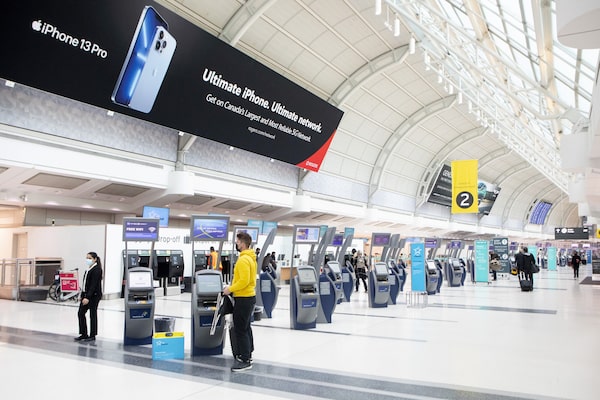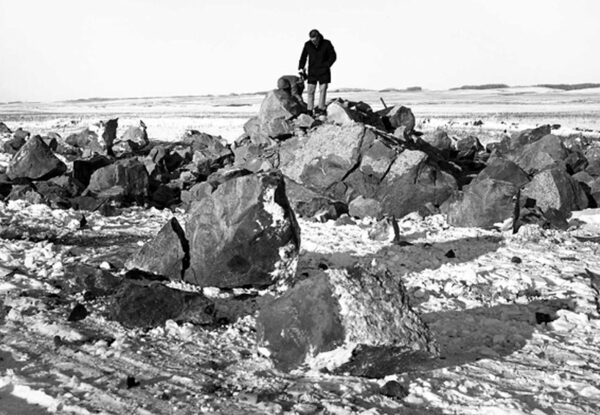Good morning,
Ottawa has announced new measures to stem the spread of the Omicron variant in Canada, expanding a travel ban to include foreign nationals from Nigeria, Malawi and Egypt and adding testing requirements for travellers returning to Canada from anywhere in the world except the United States.
Health Minister Jean-Yves Duclos said yesterday that the three African countries – which have been added to a list of seven in southern Africa where the variant has been detected – have difficulty measuring what is happening within their borders. But he explained that the decision has more to do with travellers who transit through them, not the citizens of those countries.
- Travel bans questioned after European cases reveal community transmission of COVID-19 variant Omicron
- In Omicron, experts watch warily for new tricks mixed with old
- Gary Mason: We will never live in a COVID-19-free world again. Accept it
- Ian McGugan: What the markets are telling us about Omicron fears

A passenger checks in at Toronto's Pearson Airport on Friday, Oct. 29, 2021. THE CANADIAN PRESS/Chris YoungChris Young/The Canadian Press
This is the daily Morning Update newsletter. If you’re reading this on the web, or it was forwarded to you from someone else, you can sign up for Morning Update and more than 20 other Globe newsletters on our newsletter signup page.
Opposition parties see opportunity in high inflation, but could struggle to persuade voters
Pierre Poilievre has been spoiling for a fight about inflation for the past year and a half. With the return of Parliament coinciding with the biggest surge in consumer prices in nearly two decades, the recently reappointed Conservative finance critic is getting the fracas he wanted.
Poilievre and other Conservative MPs are trying to pin rising prices on excessive government spending, while Liberal frontbenchers respond that galloping inflation is a global phenomenon.
With the annual rate of growth in the consumer price index hitting an 18-year high of 4.7 per cent in October, inflation has shot to the top of the Canadian political agenda in a way not seen since the 1980s.
- Konrad Yakabuski: Poilievre’s critique of central bank will stick if inflation lingers
- Campbell Clark: With inflation, public-sector negotiations will get tougher for Trudeau
- Andrew Coyne: Inflation is not (yet) a crisis, but it is a problem – and cheaper daycare won’t fix it
The Pope has Indigenous artifacts hidden away in the Vatican Museums. Here is a look at some of them
In 1924, Gabriel Joseph Élie Breynat, the French-born Roman Catholic bishop of the Mackenzie region of Arctic Canada, received an unusual request from his holy handlers at the Vatican: Send artifacts.
Bishop Breynat sent a rather bulky, but delicate, object: a sealskin kayak.
The kayak and some 200 other pieces of Indigenous artifacts from Canada were exhibited in 24 temporary pavilions in the Vatican along with 100,000 objects from the Americas, Africa, Asia and Australasia.
Got a news tip that you’d like us to look into? E-mail us at tips@globeandmail.com Need to share documents securely? Reach out via SecureDrop
ALSO ON OUR RADAR
Ottawa sticks with timeline for military victims’ bill of rights: The federal government is sticking to a three-year timeline to implement its promised victims’ bill of rights for the military justice system, while the opposition says it is taking too long and a legal expert warns that the delay is failing victims.
B.C. faces criticism for response during floods: The chair of British Columbia’s Fraser Valley Regional District is criticizing the province’s response to pleas for assistance during the floods, saying an urgent request for funding to shore up a road near Hope, B.C., was ignored until it was too late.
Omicron clouds economic outlook: The Canadian economy rebounded strongly in the third quarter as consumers unleashed a torrent of savings in hard-hit service industries, though a new variant of COVID-19 threatens to quell momentum.
CNN suspends Chris Cuomo: CNN indefinitely suspended anchor Chris Cuomo yesterday after details emerged about how he helped his brother, former New York Gov. Andrew Cuomo, to face charges of sexual harassment earlier this year.
MORNING MARKETS
Global markets bounce: Stock markets pushed higher on Wednesday, reversing much of the previous session’s losses, as investors used the dip in prices to bet the latest COVID-19 variant would not derail the economic recovery. Just after 5:30 a.m. ET, Britain’s FTSE 100 was up 1.38 per cent. Germany’s DAX and France’s CAC 40 gained 1.49 per cent and 1.38 per cent, respectively. In Asia, Japan’s Nikkei rose 0.41 per cent. Hong Kong’s Hang Seng added 0.78 per cent. New York futures were positive. The Canadian dollar was trading at 78.41 US cents.
WHAT EVERYONE’S TALKING ABOUT
Editorial: “Cities in Ontario are deciding what the next three decades of population growth will look like. Ottawa chose sprawl. York Region, north of Toronto, chose sprawl. Last week, Hamilton chose something different.”
Cathal Kelly: “For an instant, [Tiger] Woods wasn’t just the most famous athlete alive. He was a source of hope and a symbol of progress. It isn’t going too far to say he embodied the egalitarian promise of the new century. It is hard to accept that’s over and that golf will never see its like again. As sports tragedies go, it’s not one anyone should cry over. But it’s a tragedy nonetheless. It’s right to feel a sense of loss. But at some point, everyone has to move on.”
TODAY’S EDITORIAL CARTOON

Brian GableBrian Gable/The Globe and Mail
LIVING BETTER
The Globe 100: The books we loved in 2021
The list is in: From fiction and thrillers to cookbooks and picture books, these are the 100 books we loved this year.
MOMENT IN TIME: DECEMBER 1, 1966

Buffalo Child Stone rock after partial demolition with TNT by Prairie Farm Rehabilitation Administration in December 1966.Provincial Archives of Saskatchewan
Mistaseni (sacred rock) blown up for Sask. River dam project
Large boulders are scattered across the Prairie provinces, as if dropped from the sky. These “erratics” were carried great distances during glaciation and then deposited as the great ice sheet melted. The most famous Saskatchewan erratic was known as Mistaseni, after “big rock” in Cree, lying in the Qu’Appelle Valley near the elbow of the South Saskatchewan River. Thought to resemble a resting bison, the massive 400-tonne rock was a sacred Indigenous site for millennia. But construction of the Gardiner Dam in the early 1960s threatened to submerge the huge boulder under the artificial Lake Diefenbaker. Indigenous people wanted it saved and moved to higher ground. Two Saskatchewan Progressive Conservative MPs even asked about its fate in the House of Commons in February, 1966. The cost of relocating the rock, though, proved too prohibitive, even if engineers could figure out a way of moving it. It would be blown up instead, and some of the larger pieces used to construct a monument. Today, the Mistusinne Cairn is found at the edge of the golf course and marina in Elbow, Sask. It no longer looks anything like a resting bison. Bill Waiser
Read today's horoscopes. Enjoy today's puzzles.
If you’d like to receive this newsletter by e-mail every weekday morning, go here to sign up. If you have any feedback, send us a note.